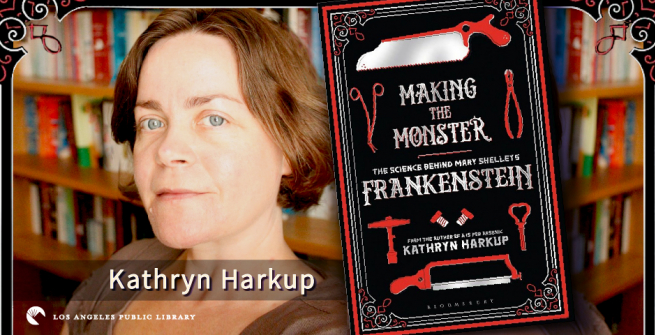Dr. Kathryn Harkup is a chemist and author. Kathryn completed a Ph.D. then a postdoc at the University of York before realizing that talking, writing and demonstrating science appealed far more than spending hours slaving over a hot fume-hood. Kathryn went on to run outreach in engineering, computing, physics and maths at the University of Surrey, which involved writing talks on science and engineering topics that would appeal to bored teenagers, and she is now a science communicator delivering talks and workshops on the quirky side of science. Her first book, A is for Arsenic: The Poisons of Agatha Christie, explores the uses of poisons in Christie’s mysteries. And, this year, for the 200th anniversary of the publication of Frankenstein: Or The Modern Prometheus by Mary Shelley, Dr. Harkup authored Making the Monster: The Science Behind Mary Shelley’s Frankenstein. Recently, she agreed to be interviewed by Daryl Maxwell for the LAPL Blog about her new book.
What inspired you to research/write Making The Monster? Was the primary motivation the Bicentennial, or was there an additional motivation for the project?
I’ve been giving talks about Frankenstein for many years now. The science behind the novel has always fascinated me. The bicentenary was a good excuse to learn more.
How long did it take you to do the necessary research and then write Making The Monster?
In total it was about 18 months of research and writing. Most of that time was reading. Perhaps the most difficult part was trying to organize all the disparate ideas and threads into a logical order.
What was the most interesting or surprising thing that you learned about Mary Shelley and/or the novel during your research?
I was delighted to find how much of a role women played in scientific learning and dissemination. Although they were effectively barred from the laboratory and carrying out experiments themselves (though there are some notable exceptions), women were well informed about science. They attended lectures, read books and discussed new discoveries. Women were very much involved in promoting scientific literacy. The works of many male scientists were written up, edited and promoted by women. One of the most popular books on science in the 19th century, written with the aim of teaching young girls about scientific principles, was written by a Jane Marcet. Her book Conversations on Chemistry influenced the likes of Michael Faraday.
Do you have a favorite Frankenstein pastiche, television or motion picture adaptation/interpretation?
Some of the Frankenstein film versions I love include Frankenweenie, the Tim Burton animation; The Rocky Horror Picture Show is fabulous, but my favourite interpretation of Victor Frankenstein and his creation is Rotwang and his robot in Metropolis.
Do you have an idea or theory regarding why/how Frankenstein has become the worldwide phenomena that it is?
It’s such a simple idea, creating a being and bringing it to life, that it can be interpreted and reproduced in thousands of different ways both serious and light-hearted. The novel itself can be read in many ways, as horror, science-fiction, a morality tale, through a feminist perspective and as a commentary on slavery. All of these are valid ways of looking at Mary Shelley’s work but at its most basic level, it is a really good read.
Thanks to theatre and film adaptations of the novel we have a vivid if inaccurate, idea of what the creature and novel are about. The green-skinned, square-headed lumbering creature is perhaps one of the most recognizable characters of the horror genre. Everyone has an idea of what Frankenstein represents even if they have never read the book.
What’s currently on your nightstand?
Venom: The Secrets of Nature’s Deadliest Weapon by Ronald Jenner and Eivind Undheim.
What was your favorite book when you were a child?
A book called Questions and Answers. I still have it.
Was there a book you felt you needed to hide from your parents?
Not really.
Can you name your top five favorite or most influential authors?
It changes all the time and it’s really difficult to cut it down to just five but some of my favorites include:
P. G. Wodehouse, John Steinbeck, David Sedaris, Andrey Kurkov, Agatha Christie.
What is a book you've faked reading?
There may be some chemistry books that I should have read at university. (quite a few)
Can you name a book you've bought for the cover?
Maybe the title rather than the cover, but Carter Beats the Devil – it exceeded expectations.
Is there a book that changed your life?
To Kill a Mockingbird. The moment when a tiny girl diffuses the rage and aggression of a large group of men has stuck with me.
Can you name a book for which you are an evangelist (and you think everyone should read)?
If This is a Man/The Truce by Primo Levi.
Is there a book you would most want to read again for the first time?
V for Vendetta by Alan Moore.
What is your idea of THE perfect day (where you could go anywhere/meet with anyone)?
A perfect day would be one where I had nothing to do but curl up with a good book and endless cups of tea. I could go on adventures and meet the most interesting people both, fictional and real-life, from the comfort of my sofa.
What are you working on now?
I’m writing my third book, The Bloody Bard, about all the ways to die in Shakespeare.

